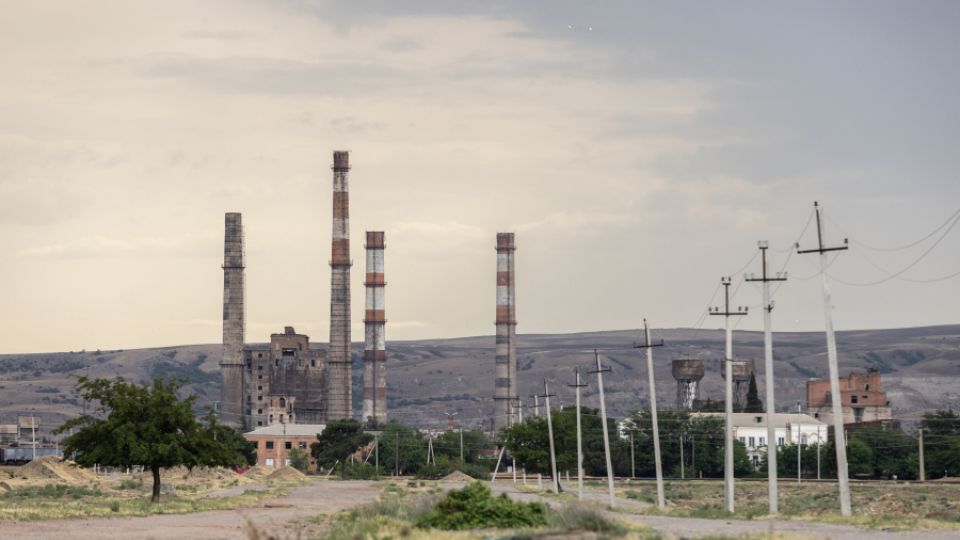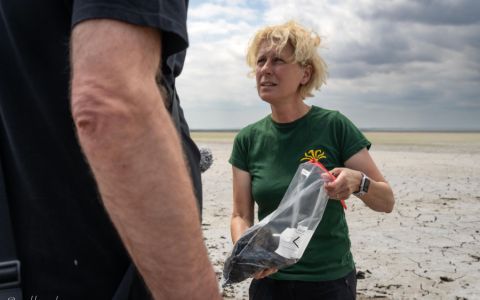TBILISI/PRAGUE - Pollution from obsolete industries, heavy traffic, old vehicles and outdated heating threaten Georgian citizens. A new study (1) based on remote sensing of the Earth carried out by the European Union satellites in the Copernicus Programme, published in collaboration with the NGOs Arnika (Czech Republic), Green Pole (Georgia) and a company World from Space, recommends the steps to improve the environment of Georgia.
“The satellite imagery shows that Rustavi is a key pollution hotspot of the country, probably due to its concentration of obsolete industries. Tbilisi is also heavily polluted, and an unregulated car traffic and insufficient public transport are among the main causes,” summarizes Jan Labohy, head of the World from Space research team. “Also, other big cities, mainly Gori, Kutaisi and Batumi, show increased pollution, probably due to the high traffic,” he adds.
The study detailing the distribution of three pollutants (NO2, CO and particulate matter - PM10) over the territory of Georgia is the result of a broad collaboration. Petr Kubernat, Czech ambassador to Georgia, states that the Czech Republic has a lot of experience to share when it comes to monitoring and seeking ways to improve air quality: “We are honoured to be able to share our know-how in cooperation with the Georgian civil society, using advanced methods such as satellite imagery from the European Copernicus programme.”
Severe air pollution, especially in major cities, has long been a thorn in the side for many Georgians. “For a long time, we have drawn attention to the extremely poor air quality in Tbilisi and in cities burdened by heavy industry or major transport hubs. By failing to use early warning methods, the state is exposing citizens to downright dangerous concentrations of, for example, suspended particles that bind dangerous chemicals (2). Now we have clear, warning data,” explains Giorgi Japaridze, chairman of the NGO Green Pole.
Air pollution in Geogria as seen from space (Download in English)
One of the threats to Georgia's air quality is the increasing volume of traffic and the large number of old vehicles. Tbilisi alone accounts for almost 40 percent of the pollution from transportation, induced by 1.5 million residents’ cars, freight and massive commuting from the hinterland. Although the situation has maybe improved slightly with the introduction of mandatory technical inspections of vehicles, enforcement and the use of alternative modes of transport remains weak, which unfortunately helps to maintain high emission levels of, for example, NO2.
Other concerns are obsolete factories of heavy industry. In Rustavi, Rustavi Steel LLC, one of Georgia’s largest industrial enterprises, and Rustavi Azot, one of the largest producers of fertilizers and industrial chemicals in the Caucasus region, are located. Rustavi has significantly higher levels of NO2 and PM10 than other cities of similar size. Kaspi and its surroundings also suffer from NO2 emissions due to the cement and glass industries. Increased pollution was also measured in Marneuli or Gardabani (4).
The authors of the analysis make a series of (5) recommendations. “Georgia is on a well-established track to improve air quality and has been adopting many of the European Union’s environmental standards and legislation. Nevertheless, it is necessary to pursue improvements in key areas, such as transport, accountability of industries, law enforcement, energy diversification and participation of the public in the decision making," summarizes Zuzana Vachunova, coordinator of international projects in Arnika.
According to the World Bank’s estimation from 2020 (3), air pollution in Georgia was responsible for around 4,000 premature deaths in Tbilisi and economic losses of around USD 560 million. The country is also one of regions most vulnerable to climate change, in particular to increased flooding, heavy rainfall, landslides, and droughts, highlighting the need for a responsible approach to both emissions of various pollutants and the protection of the environment and public health as a whole.
The study’s release was supported by the Transition Promotion Program of the Ministry of Foreign Affairs of the Czech Republic. Arnika and Green Pole recently presented an analysis of Georgia's state air pollution monitoring system (6) developed in cooperation with the Czech Hydrometeorological Institute. According to this assessment, the official system suffers from the absence of monitoring stations in the vast majority of the country. This is the shortcoming that the new citizen air pollution monitoring network AirGE is highlighting and trying to remedy. So far, it comprises twenty monitoring stations set up in collaboration of Arnika and Green Pole in Tbilisi and Rustavi.

Arnika is a Czech NGO established in 2001. Its mission is to protect nature and a healthy environment for future generations at home and worldwide. We have long advocated for less waste and hazardous substances, living rivers and diverse nature, and the right of citizens to make decisions about the environment. You can find more information about Arnika HERE.
Green Pole is a Georgia-based NGO associated with the “My City Kills Me” civic movement. The movement aims to draw attention to the issue of severe air pollution in Georgian cities, especially Tbilisi, and its health consequences. You can find more information about Green Pole HERE.
Notes:
1) Study: Air pollution in Georgia as seen from space (2023) – download in English
2) World Health Organization (2023): Impacts of pollutants on human health
3) World Bank’s report (2020): Georgia: Towards Green and Resilient Growth Georgia: Towards Green and Resilient Growth
4) Air pollution in Georgia as seen from space: Key findings on specific pollutants
Nitrogen dioxide (NO2) in Georgia is most concentrated in places with high population density, namely Tbilisi, major industrial centre Rustavi or cities like Kutaisi, Batumi and Gori. They function as transport and industrial hubs. Significantly higher concentrations of NO2 occur in winter due to heating. Concentrations are also corresponding with a road network density. The lowest concentrations are found in the mountains with little human activity.
The greatest influence on the amount of carbon monoxide (CO) in the air is elevation. High concentrations remain at the lowest elevations with mountains at the boundaries preventing dispersion. It is impossible to determine specific anthropogenic sources of CO pollution in the basic data analysis.
Analysis of the particulate matter (PM10) shows elevated concentrations primarily in the southeast due to dust picked up by the wind. High concentrations around cities and their main highway connectors, with Tbilisi and Rustavi having the highest averages. The distribution of PM10 is caused by natural processes, with summer and spring affecting Tbilisi and Rustavi due to particles spreading from the drier east westwards, and winter and autumn peaks around cities due to household heating.
5) Air pollution in Georgia: Expert recommendations
Energy efficiency measures
Financial instruments backed by strong energy efficiency rules based on the EU’s policies can significantly reduce energy consumption and associated emissions. This involves the renovation of buildings and industries, promoting energy-efficient equipment, retrofitting buildings, and implementing smart transportation solutions. Policy instruments such as audits, technical competence requirements, and implementation of energy management systems need to be used, with a focus on efficient district heating and cooling.
Modernisation of transport
It is required to strengthen the authority of emission and technical controls for cars, trucks and motorised means of public transport. The public transport in Tbilisi and its metropolitan area is at a fairly good level and old diesel buses are being replaced with new CNG vehicles. However, it should be developed further. A daily commute regime should be analysed for a proper reinforcement of public transport from the hinterland. Other larger cities, such as Kutaisi, Batumi or Rustavi, would benefit from a similar public transport renewal.
Emission control measures for industries
Georgian authorities should implement pollution control, require cleaner production and enforce strict standards. Financial support (subsidies) also helps. Sector-specific roadmaps should outline key steps and targets. Development could be supported by technology transfers from international institutions. Innovative solutions will also provide new business opportunities. Nevertheless, many of the larger facilities (e. g. GeoSteel, Rustavi; Kaspi Cement Plant) are driven by foreign capital, and the Georgian authorities should demand investments in up-to-date technologies.
Regulatory frameworks and environmental liability
Allocation of adequate resources, including funding, staffing, and training is essential. Emphasis should be put on enforcing the legislature, which need to advance against the lobby and corruption. Regular inspections and audits of pollution sources should be done to verify compliance with environmental regulations. Stringent penalties should raise awareness about the consequences of non-compliance with air quality regulations.
Renewable energy deployment
The geographic distribution patterns of air pollution do not always convincingly expose anthropogenic sources. This partly points to the country’s current energy sector with more than 80 % of electricity generated by hydropower sources. The appeal must be put on preventing the building of new fossil fuel power plants, gradual reduction of the share of fossil fuels and diversification among renewable sources. To attract business interest in the renewable energy sector, it is recommended to establish supportive policies, feed-in tariffs, and investment incentives.
Monitoring and open data
Automated nation-wide system of air pollution monitoring should be introduced, providing continuously data on concentrations of individual pollutants. Other open information systems should contribute to better understanding of air pollution and its sources, such as PRTR (Pollution Release and Transfer Register), presenting annual volume of emissions from major sources.
Public awareness and participation
It is recommended to foster raising awareness among the public about the health impacts of air pollution. To encourage public participation in decision-making processes user-friendly platforms and tools for accessing and understanding data are crucial. The public should be invited much more actively to participate in preparation of specific policies.







